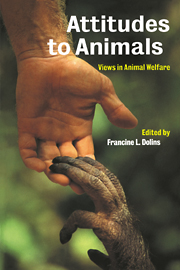Book contents
- Frontmatter
- Contents
- List of contributors
- Acknowledgements
- Part I Attitudes to animals
- Part II Animal awareness
- Part III Animal welfare
- Part IV Research and education
- 12 Humane education: the role of animal-based learning
- 13 ‘Minding animals’: the role of animals in children's mental development
- 14 Alternatives to using animals in education
- 15 Animals in scientific education and a reverence for life
- Part V Epilogue: the future of wild animals
- Index
13 - ‘Minding animals’: the role of animals in children's mental development
Published online by Cambridge University Press: 16 November 2009
- Frontmatter
- Contents
- List of contributors
- Acknowledgements
- Part I Attitudes to animals
- Part II Animal awareness
- Part III Animal welfare
- Part IV Research and education
- 12 Humane education: the role of animal-based learning
- 13 ‘Minding animals’: the role of animals in children's mental development
- 14 Alternatives to using animals in education
- 15 Animals in scientific education and a reverence for life
- Part V Epilogue: the future of wild animals
- Index
Summary
Introduction
There is a profound, inescapable need for animals that is in all people everywhere, an urgent requirement for which no substitute exists. … It is the peculiar way that animals are used in the growth and development of the human person in those most priceless qualities which we lump together as ‘mind’. It is the role of animal images and forms in the shaping of personality, identity and social consciousness. Animals are among the first inhabitants of the mind's eye. They are basic to the development of speech and thought [and] are indispensable to our becoming human in the fullest sense.
(Shepard, 1978, p. 2)Shepard's thesis is that the presence of animals is integral to the development of human mind. In western culture at least, all children use animal imagery in the development of consciousness because, historically, thought arose, in large part, from the interactions between people and animals. This intimate connection linking animals to the development of speech, rationality, emotion and consciousness, is not the same as thinking about animals. Rather, it is what Shepard calls ‘minding animals’ (1978, p. 249); that is, it is in the act and nature of thought, and it is essential in the development of self-identity and self-consciousness (1978).
It is not only the presence of animals that is important to human development, but also an understanding of the nature of animal consciousness itself (Griffin, 1992). Considerable comparative research has been done in this area, raising questions not only about the nature of animal mind and the development of human mind, but also about the ethical treatment of animals.
- Type
- Chapter
- Information
- Attitudes to AnimalsViews in Animal Welfare, pp. 186 - 199Publisher: Cambridge University PressPrint publication year: 1999
- 4
- Cited by



